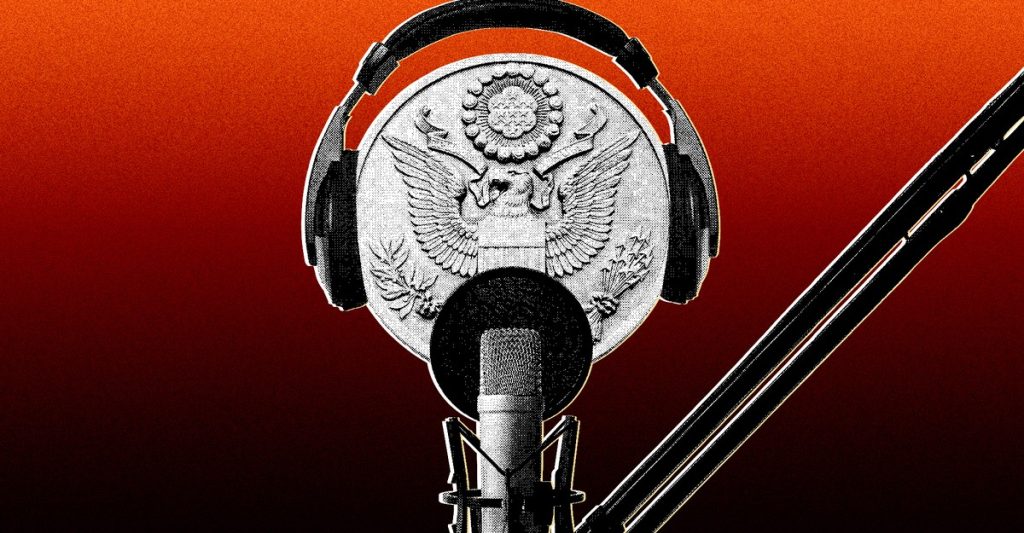The Blurring of Media and Government in the Trump Administration
A New Era of Appointments: Podcasters in Power
Donald Trump’s second term has ushered in a unprecedented shift in how he selects top officials for his administration. Unlike his first term, where he relied on traditional professionals like lawyers, CEOs, academics, and military leaders, Trump is now turning to a surprising new talent pool: podcasters. In recent weeks, he has appointed two high-profile right-wing podcasters, Dan Bongino and Graham Allen, to key roles. Bongino, known for his popular conservative podcast, has been named deputy director of the FBI, while Allen, host of the Dear America Podcast, will serve as a top communications official at the Department of Defense. These appointments are striking not only because of their unconventional backgrounds but also because both men have used their platforms to promote extreme conspiratorial views. For instance, Bongino has claimed that the pipe bombs near the Capitol on January 6, 2021, were an “inside job,” that the 2020 election results were fraudulent, and that checks and balances in government matter less than raw “power.” Similarly, Allen has alleged that climate change is a liberal plot to control people and even referred to Taylor Swift as “a witch and a devil.” Their lack of relevant experience—Bongino has no prior FBI background, and Allen’s credentials are similarly thin—has raised eyebrows across the political spectrum.
The Rise of Right-Wing Media in Government
Bongino and Allen are not outliers in Trump’s administration. They are part of a growing cohort of right-wing media figures who have been appointed to high-ranking roles. For example, Darren Beattie, founder of the conspiracist website Revolver News, now works at the State Department, while former Fox News host Pete Hegseth serves as secretary of defense. These individuals have earned Trump’s trust by using their platforms to enthusiastically promote the MAGA agenda, effectively creating a quasi-state media apparatus. However, as these media personalities transition into government roles, the line between the Trump administration and right-wing media has become increasingly blurred. This phenomenon marks a new kind of singularity, where media figures and politicians are no longer separate entities but intertwined in their goals and operations.
Historical Context: Media and Politics Blur
While it’s not entirely unprecedented for media personalities to move into politics—especially in communication roles—Trump’s recent appointments represent something more extraordinary. During his first term, Trump brought in figures like Steve Bannon, the former head of Breitbart News, as his chief strategist, and Larry Kudlow, a former CNBC host, to lead the National Economic Council. Even earlier, figures like Jay Carney left journalism to become President Barack Obama’s press secretary. However, the current trend in Trump’s administration goes beyond these precedents. The barriers between media and government are eroding in ways that were previously unimaginable. For instance, Charlie Kirk, founder of Turning Point USA and a prominent right-wing media figure, has reportedly advised Trump on key appointments, despite holding no official government position. Similarly, Jack Posobiec, a conspiracy theorist and influencer, has been invited on official trips overseas, even claiming to have met with Ukrainian President Volodymyr Zelensky. These developments suggest a new level of integration between right-wing media and the Trump administration.
The Influence of Right-Wing Media on Policy
The integration of right-wing media into the Trump administration has significant implications for policy and governance. Many of these figures, now in positions of power, have used their platforms to advocate for far-right ideologies. Their influence is evident in the administration’s recent moves, such as proposed mass deportations, punitive tariffs, and attempts to dismantle federal agencies. The executive branch now appears to reflect the fever dreams of far-right podcasters, with policies that align closely with the rhetoric of figures like Bongino and Allen. This shift has been accompanied by a growing distrust of traditional media among the right, with many conservatives turning to alternative sources of information. As Bongino declared in November, “We are the media now,” a phrase that has resonated with an online right-wing movement deeply skeptical of legacy news outlets. While this statement is only partially true—right-wing influencers like Bongino do serve as a primary source of information for millions of Americans—it underscores the growing convergence of media and government.
The New Media-State Singularity
The breakdown of the barriers between media and government under Trump has created a unique political landscape. Right-wing podcasters like Bongino and Allen are no longer just commentators; they are policymakers. At the same time, right-wing politicians, such as Ted Cruz and Dan Crenshaw, have embraced podcasting as a way to connect with their base. This overlap is not exclusive to the right; figures like California Governor Gavin Newsom have also launched podcasts. However, on the right, the relationship between media and politics is more explicitly transactional, with both sides working toward the same goals. This has created a system in which right-wing media figures are not just amplifying Trump’s agenda but shaping it from within.
The Implications of a Media-Driven Government
The consequences of this media-state singularity are profound. By integrating right-wing influencers into his administration, Trump has effectively created a government that operates in lockstep with a specific ideological ecosystem. The administration has further reinforced this dynamic by barring mainstream media outlets like the Associated Press from covering White House events while granting access to right-wing figures like Lara Logan, despite her extremist views. Even in moments like the release of documents related to the Jeffrey Epstein investigation, the Department of Justice has prioritized sharing information with right-wing influencers over traditional journalists. This approach not only undermines the independence of the press but also consolidates power within a tightly controlled media ecosystem. As a result, the Trump administration’s policies and communications are increasingly shaped by the far-right media’s priorities, leading to a government that feels less accountable to the broader public and more aligned with the interests of its ideological allies. This phenomenon represents a significant shift in how power operates in the United States, with far-reaching implications for democracy and governance.


